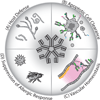Manipulation of the glycan-specific natural antibody repertoire for immunotherapy
- PMID: 26864103
- PMCID: PMC4755354
- DOI: 10.1111/imr.12397
Manipulation of the glycan-specific natural antibody repertoire for immunotherapy
Abstract
Natural immunoglobulin derived from innate-like B lymphocytes plays important roles in the suppression of inflammatory responses and represents a promising therapeutic target in a growing number of allergic and autoimmune diseases. These antibodies are commonly autoreactive and incorporate evolutionarily conserved specificities, including certain glycan-specific antibodies. Despite this conservation, exposure to bacterial polysaccharides during innate-like B lymphocyte development, through either natural exposure or immunization, induces significant changes in clonal representation within the glycan-reactive B cell pool. Glycan-reactive natural antibodies (NAbs) have been reported to play protective and pathogenic roles in autoimmune and inflammatory diseases. An understanding of the composition and functions of a healthy glycan-reactive NAb repertoire is therefore paramount. A more thorough understanding of NAb repertoire development holds promise for the design of both biological diagnostics and therapies. In this article, we review the development and functions of NAbs and examine three glycan specificities, represented in the innate-like B cell pool, to illustrate the complex roles environmental antigens play in NAb repertoire development. We also discuss the implications of increased clonal plasticity of the innate-like B cell repertoire during neonatal and perinatal periods, and the prospect of targeting B cell development with interventional therapies and correct defects in this important arm of the adaptive immune system.
Keywords: B-1 B cell; clonotype; glycan neodeterminant; innate-like B lymphocyte; natural antibody; repertoire development.
© 2016 John Wiley & Sons A/S. Published by John Wiley & Sons Ltd.
Conflict of interest statement
The authors possess no potential conflicts of interest at the time of manuscript preparation.
Figures





References
-
- Kantor AB, Herzenberg LA. Origin of murine B cell lineages. Annu Rev Immunol. 1993;11:501–538. - PubMed
-
- Martin F, Oliver AM, Kearney JF. Marginal zone and B1 B cells unite in the early response against T-independent blood-borne particulate antigens. Immunity. 2001;14:617–629. - PubMed
-
- Kearney JF, Patel P, Stefanov EK, King RG. Natural antibody repertoires: development and functional role in inhibiting allergic airway disease. Annu Rev Immunol. 2015;33:475–504. - PubMed
Publication types
MeSH terms
Substances
Grants and funding
LinkOut - more resources
Full Text Sources
Other Literature Sources

